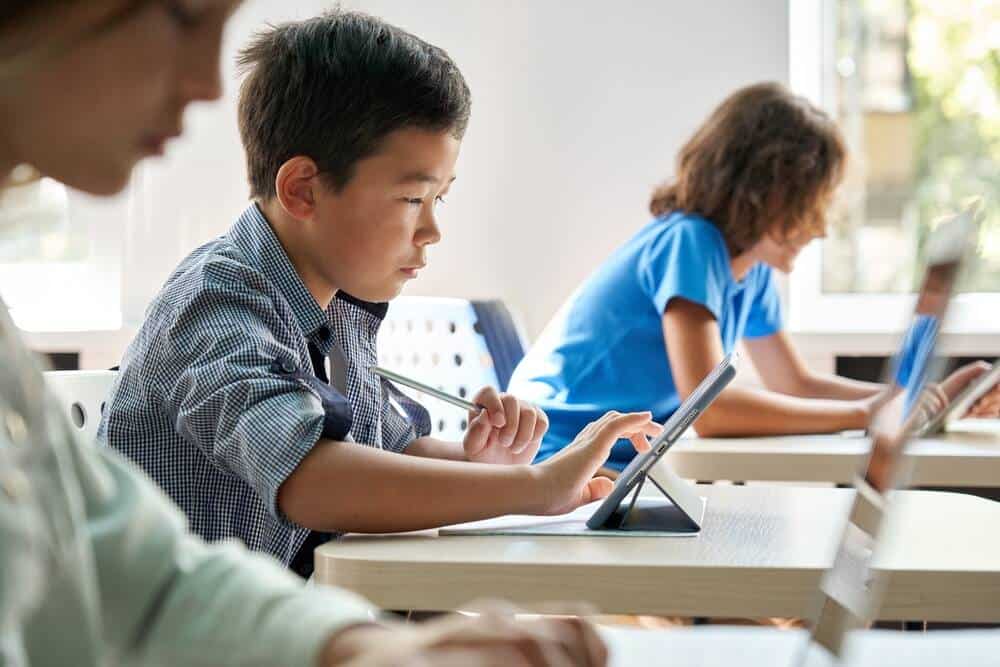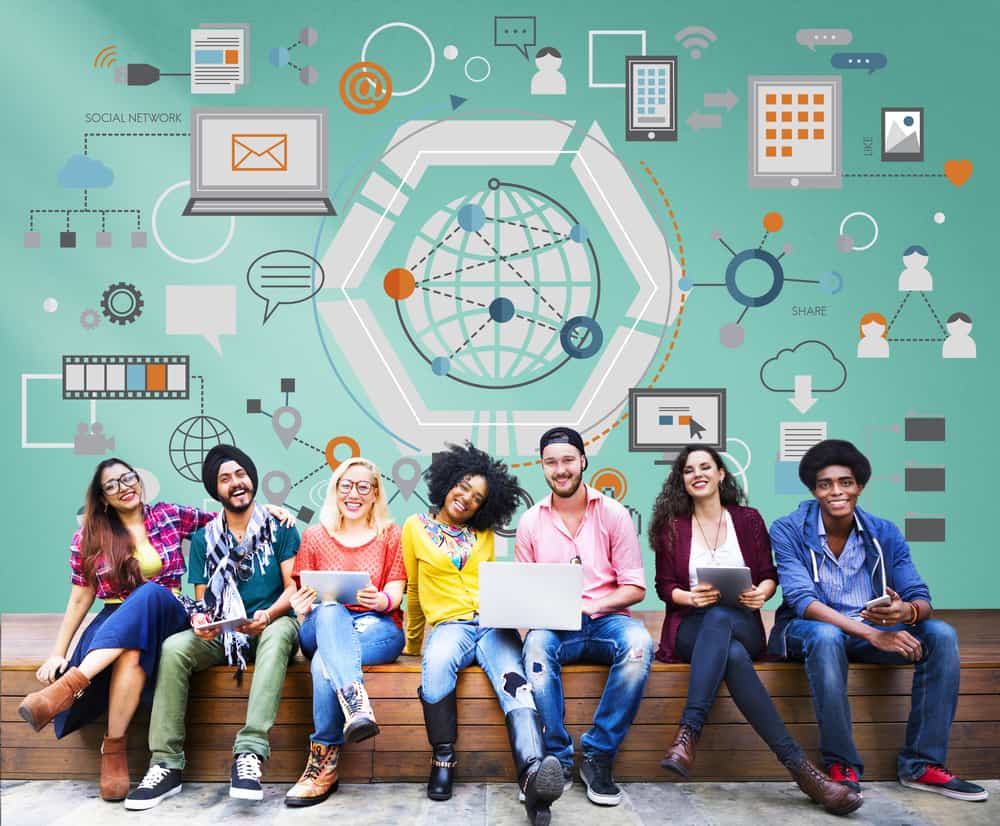- What are the benefits of the IoT in education?
- Examples of the IoT in education
- Challenges and considerations of the IoT in education
The Internet of Things (IoT) is a network of hardware, sensors, and software connected via the internet. The IoT enables increasingly efficient transmission of data, not only between devices and humans, but among devices as well. The IoT is used in many different sectors, ranging from retail, healthcare, and logistics to government, finance, and construction. Another area where the IoT is slowly but surely starting to make an entrance – and where it could have a significant impact – is education. From more efficient teaching methods and online courses to integrated mobile technology, IoT-enabled education can be a valuable addition to pens, paper and chalkboards as learning opportunities and instructional approaches continue to expand. More and more educational institutions are looking into ways to better accommodate student needs, improve efficiency, and make learning more engaging. And for educators, the IoT can improve organisation, administration, data collection, and make teaching more efficient and rewarding.
What are the benefits of the IoT in education?
IoT in education means a better-connected and more collaborative future for students as well as teachers. IoT connectivity and devices offer students better access to everything from communication channels to learning materials, and give educators the ability to measure learning progress in real time. The IoT also enables the automation of various tasks, improves school management, facilitates real-time data collection, powers smart lighting systems for better and more energy efficient illumination, and provides a safer learning environment through the use of smart cameras, smart ID cards, and smart access control. It can help make the use of tablets and smartphones more efficient, automate attendance-keeping, monitor a student’s whereabouts on campus, expand smartboard functionalities to improve interactivity, enable predictive maintenance for school infrastructure and equipment, keep parents updated on things like test results, and more.
More efficient use of tablets and smartphones
More and more children and young adults have access to smart devices than ever before, and their screen time has seen significant increase in recent years. While screen time should be monitored and – insofar possible, limited – there are many benefits to using smart devices as well. Combining smart devices with the IoT can help create an infrastructure that enables students to log into their learning software at any time and from anywhere, using their tablets or smartphones. This transitions them from the blackboard to a smart learning environment where they can leverage digital technology to learn; think watching videos, having online group discussions, making notes in their digital textbooks, highlighting important chapters or paragraphs, attending webinars, and so much more.

Improved school management and real-time data collection
Managing an educational institution is not an easy task. It entails ensuring the physical and emotional wellbeing of students, providing an effective and safe learning environment, keeping track of supply management, lots of planning and paperwork, and funds allocation or redistribution. These tasks – due to tight budgets and tight schedules – can be quite challenging. An interconnected system of devices like the Internet of Things can be of great value as it can automate various tasks, provide a holistic overview of educational processes, and enable a valuable decision-making framework. Collecting and analysing data in real time can help educators streamline and finetune their teaching methods. And having a system that sends out an alert when it notices a student struggling can help improve learner performance and – simultaneously – help the teacher adapt his or her teaching methods. Real-time data collection and analysis can also help make testing and grading more efficient. The IoT can help educators teach students in interactive ways, which helps them learn concepts more effectively. The IoT also facilitates the transcription of lessons through the use of smart microphones, enabling students to save and playback the lessons, or store them as digitally printed notes that can be reviewed at a later time.
A safer learning environment
A safe learning environment is one of the cornerstones of a solid education, and a great conduit for learning. The IoT enables all kinds of applications that can increase safety and security within educational institutions and make the lives of students much more comfortable. Think video monitoring tools that can identify suspicious individuals and RFID technology combined with IoT-enabled access-control devices to monitor each student’s location – which is helpful in case of emergencies. Students equipped with RFID wristbands or smart ID cards will automatically be registered as soon as they enter the school, making attendance keeping more efficient. And should students decide to play truant, they can be prevented from leaving the premises by locking the doors with remote access-control devices. Linking access-control systems to the internet also enables parents to automatically be kept updated on their child’s whereabouts, and helps school administrations with real-time accessible punctuality reports. The IoT can also help improve online safety by protecting all systems as well as sensitive student information with firewalls and authentication mechanisms.
Improved energy efficiency
The IoT can also play an important role in optimising the use of electricity and minimising water consumption by controlling the HVAC systems. Having a system implemented that incorporates sensor technology to adjust the lighting to the usage of the classrooms, the time of day, and the weather, can make a huge difference in operational costs. These systems can help educational facilities keep track of free study or meeting rooms, or streamline the reservation process for the use of computers in school libraries. Using the IoT, educational institutions can individually monitor devices like water heating systems, lighting systems, and air conditioning systems, and once enough information is collected over time, AI algorithms can analyse this data, develop historic trends and predict future usage, or pinpoint areas where usage can be optimised. Advanced IoT smart sensors can track individual people and register exactly where they are in a building. This enables school management to choose which sections or classrooms in the building to switch on or off, and when – providing optimal energy efficiency.
Examples of the IoT in education
After having discussed the impact of the IoT on education, let’s take a look at the various IoT solutions that are already implemented at educational institutions around the world, and how they reshape education as we know it.
Video-based education platform Kaltura is developed for online instruction
The US-based company Kaltura has developed a video cloud platform that provides schools with a video creation and management service. It supports real-time, live and VOD experiences for online and virtual learning, and includes virtual classrooms, a video portal, video messaging, and support options for webinars. The Kaltura virtual classroom also features screen sharing options, real-time notes, a whiteboard, and tools like translation, transcription, and automatic chaptering. In a bid to help educators improve student engagement, the platform also offers features like live quizzes and editing tools that allow users to capture, optimise, and repurpose video content. The platform is highly customisable and integrates with all major learning management systems and video learning environments (VLEs).
Smart pen scanner helps students master new words and definitions
The C-PEN scanner combines patented camera technology and optical character recognition (OCR) software to capture and process printed text and reads the scanned text aloud. C-PEN can also store the scanned text and provide definitions for highlighted words, making it a valuable study assist tool. The smart pen scanner can help students master new words and definitions, and even store selected parts of a textbook lesson. The manufacturer of the C-PEN also developed a translator pen that “translates and pronounces words based on nine Oxford Academic and English Language Teaching (ELT) dictionaries”. This makes the C-PEN very useful for non-English speaking students as it can help them do their research and studies more efficiently.
Smart, interconnected data-collecting cards
The UK-based ID card printer manufacturer Magicard has developed a card-based IoT solution that improves student safety. The company created physical cards that can serve as physical access cards, ID cards, payment cards, and more. Each card has a unique code that is used to access school facilities and classrooms. The cards can also be used to track student attendance and notify teachers about whether the student is in the right class at the right time, or the amount of time someone has been absent in the case of sick leave. Magicards can also be embedded with logical access application technology, informing educators how often students use specific e-learning materials and whether they submit their assignments on time. The cards can also store personal information, emergency contacts, and so on.
Challenges and considerations of the IoT in education
Although the IoT has many potential applications in education, there are also a number of challenges and considerations that need to be taken into account. Here are two of the most important ones.
Technology is not readily available to every student
The implementation of the IoT can be hampered by unequal access to technology among students. The functioning of the IoT relies on students’ use of technology at home, such as in the flipped classroom model. And in order to prevent or combat tech disparity, not only between students, but also between schools or school districts, many students may have to be supplied with devices, which might lead to much greater costs, which in turn could impede the implementation of the IoT. And apart from purchasing the required equipment and having it installed, schools would also have to pay for its maintenance, training their teachers, and hiring additional staff members to manage the running of the IoT system. Implementing the IoT would, however, pay off in the long run if educational institutions would invest money in devices with longer lifespans that require minimal maintenance and make use of royalty-free software.
Vulnerability to data theft and cyberattacks
Other challenges associated with the use of the IoT in education include concerns about privacy and security. The fact that using the IoT involves the collection and storage of all kinds of digital information puts educational institutions at greater risk of falling victim to cyberattacks. What’s more, some parents might not particularly appreciate having their children ‘digitally profiled’ by AI-powered software. And indeed a huge amount of information will be collected, such as a student’s personal details, learning history, and his or her location throughout the day – leading to privacy concerns that will need to be carefully addressed. To ensure data privacy and online safety, it’s important for educational institutions to invest in protective measures and contingency plans in the event of cyberattacks, data breaches, or other threats, which will require a highly skilled tech team. Furthermore, students will need to be educated on the importance of online security to protect them from data breaches.
In closing
Overall, the IoT and its virtually endless possibilities has already proved its worth in education. In the classroom, the IoT is not only beneficial to students, but to educators as well. It helps collect meaningful and relevant data in real time, which enables schools and educators to plan more efficiently and helps fine-tune and improve curricula. Obviously, some applications of IoT are more suited to school management and maintenance, instead of it directly impacting student learning. However, money saved by smart usage of electricity through the IoT can be invested in the improvement of learning materials. The benefits of the IoT in education will range from more interactive teaching methods and, as a result, improved student engagement to increased safety and security, and more time for teachers to spend on more meaningful tasks.




